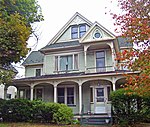Lackawanna Heritage Valley National and State Heritage Area
The Lackawanna Heritage Valley National and State Heritage Area is a state and federally designated National Heritage Area in northeastern Pennsylvania. It was initially established in 1991 as the first State Heritage Park in Pennsylvania, and was additionally designated a National Heritage Area in 2000. The designations recognize the area's heritage of industry, architecture, history and natural resources, and provide a framework for development and promotion of these features. The Lackawanna Heritage Valley National and State Heritage Area is managed by the Lackawanna Heritage Valley Authority, or LHVA. The National Heritage Area comprises the Lackawanna River watershed as it descends through Carbondale and Scranton to its junction with the Susquehanna River at Pittston. The heritage area covers portions of Lackawanna, Susquehanna, Wayne and Luzerne counties. The area is strongly identified with anthracite coal mining and the industries which depended on the coal, such as railroading, locomotive-building and rail-making.Major components of the heritage area include Steamtown National Historic Site, the Pennsylvania Anthracite Heritage Museum and the Electric City Trolley Museum.
Excerpt from the Wikipedia article Lackawanna Heritage Valley National and State Heritage Area (License: CC BY-SA 3.0, Authors).Lackawanna Heritage Valley National and State Heritage Area
South 7th Avenue, Scranton
Geographical coordinates (GPS) Address Nearby Places Show on map
Geographical coordinates (GPS)
| Latitude | Longitude |
|---|---|
| N 41.408888888889 ° | E -75.676666666667 ° |
Address
Lackawanan Heritage Valley Partners
South 7th Avenue 213
18505 Scranton
Pennsylvania, United States
Open on Google Maps







